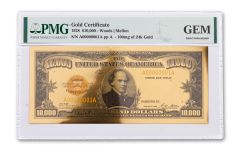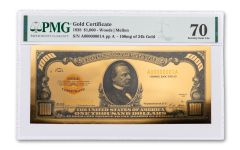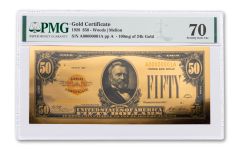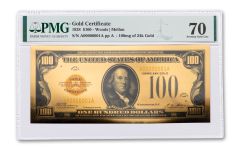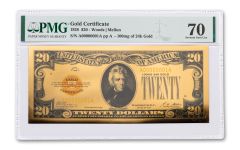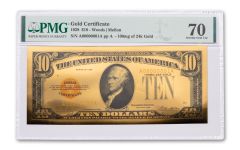Local Storage seems to be disabled in your browser.
For the best experience on our site, be sure to turn on Local Storage in your browser.
Gold Certificates
Collectors who have an interest in monetary history, especially American monetary history, should have gold certificates in their collections. The certificates were first authorized in 1863 in the middle of the Civil War, but it seems as though they were not printed until 1865. The first certificates were not printed with dates and were instead hand dated upon issue. The certificates were redeemable in gold at a rate of $20.67 per troy ounce. They continued to be used until 1933, when President Franklin Delano Roosevelt took the United States off the gold standard and recalled all gold. Even ownership of the certificates was rendered illegal until 1964, when the notes were converted to legal tender and could be sold freely among collectors. Keep reading to learn more about U.S gold certificates and to browse our inventory below.
1928 $10000 24K 100 mg Gold Certificate Commemorative PMG GEM
$29.95 As Low As $29.07- Qty Credit Card Wire
- 1+ $29.95 $29.07
In Stock1928 $10000 24K 100 mg Gold Certificate Commemorative PMG 70
$49.95 As Low As $48.48- Qty Credit Card Wire
- 1+ $49.95 $48.48
In Stock1928 $1000 24K 100 mg Gold Certificate Commemorative PMG 70
$49.95 As Low As $48.48- Qty Credit Card Wire
- 1+ $49.95 $48.48
In Stock1928 $50 24K 100 mg Gold Certificate Commemorative PMG 70
$49.95 As Low As $48.48- Qty Credit Card Wire
- 1+ $49.95 $48.48
In Stock1928 $100 24K 100 mg Gold Certificate Commemorative PMG 70
$49.95 As Low As $48.48- Qty Credit Card Wire
- 1+ $49.95 $48.48
In Stock1928 $20 24K 100 mg Gold Certificate Commemorative PMG 70
$49.95 As Low As $48.48- Qty Credit Card Wire
- 1+ $49.95 $48.48
In Stock1928 $10 24k 100 mg Gold Certificate Commemorative PMG 70
$49.95 As Low As $48.48- Qty Credit Card Wire
- 1+ $49.95 $48.48
In Stock
Large U.S Gold Certificates
In 1928, the size of U.S currency, including gold certificates, changed. Large U.S gold certificates were issued prior to that point. They were replaced with smaller versions from 1928 forward. The backs of the larger certificates, as well as the backs of the rare 1934 notes, were gold, which led to the nickname ‘goldbacks.’ This contrasted with the Series of 1928 bills, which were green. Even today, the fiat U.S dollar is commonly referred to as “the greenback.”
The 1922 Gold Certificate
In 1922, the first ever $10 gold certificates were issued. The notes feature a portrait of the first Treasurer of the United States, Michael Hillegas, on the obverse. The reverses were printed with gold ink, reinforcing their gold backing. Manny of these notes were destroyed following President Roosevelt’s decision, yet some survive in Fine condition. GovMint.com currently has some of these notes available. Each one that we sell comes with a certificate of authenticity, which is particularly important given the unique history of these certificates.
The 1928 Gold Certificate
Gold certificates shrunk and were redesigned in 1928. Their design was similar to the one that was used until the recent redesign of U.S $10 notes. The reverse for this note was green, but gold was still included. A seal and serial numbers both featured on the obverse. They appear next to a portrait of Alexander Hamilton, who continues to appear on $10 bills today. A vignette of the U.S Treasury Building features on the reverse. As with the 1922 Gold Certificates, these only survived illegally in private hands, as most were destroyed following the prohibition on private gold ownership.

